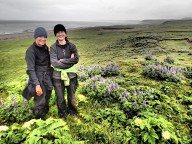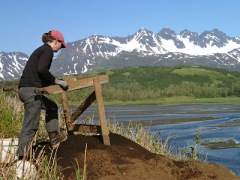
Catherine West and her research assistant stand atop a midden on Chirikof Island, Alaska. This will become one of five excavation sites for West’s 2013 research. (Photo by Patrick Saltonstall, Alutiiq Museum)
Catherine West is not looking to the future when it comes to climate change- she’s looking back. About 5,000 years back, at archeological evidence left behind by the Alutiiq people who once occupied Chirikof Island, Alaska.
Historically, diets can show what food resources were available to a population. Leftovers from last nights dinner (however many thousands of years ago) were discarded on the landscape or in pits by the Alutiiq hunter/gatherer society. In some cases the leftovers build up over time. Archeologists like West can look at these pits, or middens, and create a record of what people ate and what resources were available to them.
Excavating middens is a bit like sorting through the trash. Exposed to the elements or other variables, the contents of the pits can decompose.

Catherine West and her team excavate middens on Kodiak Island neighboring Chirikof Island, Alaska. (Photo by Patrick Staltonstall, Alutiiq Museum)
But not everything rots.
Fragments of bones and shells, and in well-preserved middens sometimes hair and oil, are left behind. And “what’s left behind is what I have to interpret,” said Dr. West, of Boston University.
West spent ten days on the uninhabited Chirikof Island this past summer looking at middens left sometime in the past 5,000 years by the Alutiiq people.
Mostly, West looks at the bones. First she sorts them out into marine mammal, fish and birds, and then she identifies them. Eventually she will send them to the lab to be radiocarbon dated.

Chatherine West sifts through dirt from a midden on Kodiak Island, Alaska. She is looking for human waste remains like bones or shells. (Photo by Patrick Saltonstall, Alutiiq Museum)
After identifying and aging the bones, West can start to create a timeline of which resources were being used by hunter/gatherer societies at certain times throughout the past.
Further lab tests look at nitrogen and oxygen within the bones, which can provide clues about what an animal ate and whether its diet consisted of terrestrial or marine prey. This is a whole other depth to the information scientists can extrapolate from these middens. Using this information, West can retroactively piece together historic food webs.
As West fills in more information about the food webs, she can start to look for shifts in resources that are available to or used by the Alutiiq people. Also, she can compare what scientists already know about historic climate shifts to what she knows the Alutiiq people were eating at that time. She can start to answer questions about whether or not climate change affects the diets/resources of these people.
Her task is not a small one.
“The major gap that we see now is that there are a lot of these long term records,” said West. “We have huge animal bone records from around the world, we have lots of climate proxies for the past in the archeological record, we know a lot about contemporary environmental conditions- but the connection between the past and the present has not been made very successfully by a lot of people.”
That’s why West went to Chirokof Island this summer- to see if she can find the connection between the past and the present. Once she does, she can start asking bigger questions like: “can I apply those long term records to contemporary environmental questions?”
The answer: only time will tell.

Outstanding, Hannah!
Interesting to say the least. Nice report on this Hannah. I enjoy reading your writings; I can always tell its you from your unique style. I can hear your voice while I read. Great job!
It was great to meet you, Hannah! Good luck with your blog!